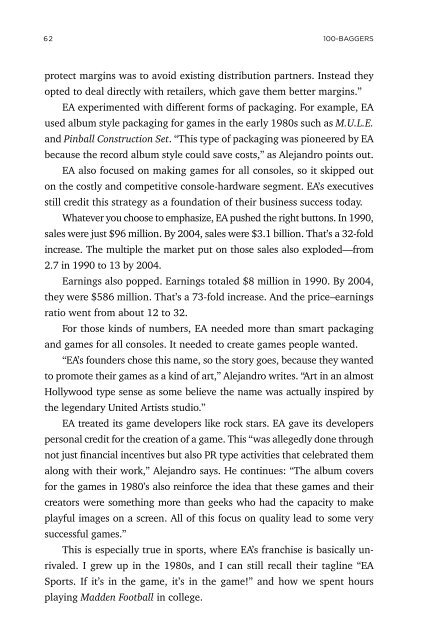Create successful ePaper yourself
Turn your PDF publications into a flip-book with our unique Google optimized e-Paper software.
62<br />
100-BAGGERS<br />
protect margins was to avoid existing distribution partners. Instead they<br />
opted to deal directly with retailers, which gave them better margins.”<br />
EA experimented with different forms of packaging. For example, EA<br />
used album style packaging for games in the early 1980s such as M.U.L.E.<br />
and Pinball Construction Set. “This type of packaging was pioneered by EA<br />
because the record album style could save costs,” as Alejandro points out.<br />
EA also focused on making games for all consoles, so it skipped out<br />
on the costly and competitive console-hardware segment. EA’s executives<br />
still credit this strategy as a foundation of their business success today.<br />
Whatever you choose to emphasize, EA pushed the right buttons. In 1990,<br />
sales were just $96 million. By 2004, sales were $3.1 billion. That’s a 32-fold<br />
increase. The multiple the market put on those sales also exploded—from<br />
2.7 in 1990 to 13 by 2004.<br />
Earnings also popped. Earnings totaled $8 million in 1990. By 2004,<br />
they were $586 million. That’s a 73-fold increase. And the price–earnings<br />
ratio went from about 12 to 32.<br />
For those kinds of numbers, EA needed more than smart packaging<br />
and games for all consoles. It needed to create games people wanted.<br />
“EA’s founders chose this name, so the story goes, because they wanted<br />
to promote their games as a kind of art,” Alejandro writes. “Art in an almost<br />
Hollywood type sense as some believe the name was actually inspired by<br />
the legendary United Artists studio.”<br />
EA treated its game developers like rock stars. EA gave its developers<br />
personal credit for the creation of a game. This “was allegedly done through<br />
not just financial incentives but also PR type activities that celebrated them<br />
along with their work,” Alejandro says. He continues: “The album covers<br />
for the games in 1980’s also reinforce the idea that these games and their<br />
creators were something more than geeks who had the capacity to make<br />
playful images on a screen. All of this focus on quality lead to some very<br />
successful games.”<br />
This is especially true in sports, where EA’s franchise is basically unrivaled.<br />
I grew up in the 1980s, and I can still recall their tagline “EA<br />
Sports. If it’s in the game, it’s in the game!” and how we spent hours<br />
playing Madden Football in college.


